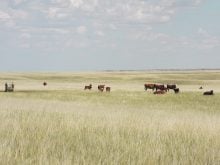Veterinarians are reporting death rates this year from normal to 10 percent; typical rates are two to three percent
Veterinarians say many producers across the Prairies experienced higher than normal calf deaths this year, pointing to the long winter, a vitamin shortage and poor forage quality as the main culprits.
While prairie- and province-wide data is unavailable, some veterinarians saw calf deaths range anywhere from normal to 10 percent. There was also at least one case where calf loss reached 25 per cent.
Typical death rates average two to three percent, according to previous surveys by the University of Saskatchewan, therefore making this year the “calving season from hell” for some producers, said Dr. Eugene Janzen, a veterinarian and professor with the University of Calgary.
Read Also

Trump’s tariffs take their toll on U.S. producers
U.S. farmers say Trump’s tariffs have been devastating for growers in that country.
“That’s what some producers were saying and I’ve never heard it phrased like that,” he said.
“We could expect our calf crop to be severely affected.”
Janzen said of the 12 to 15 herds he helped, he saw calf death rates reach 10 percent and go as high as 25 percent. Other veterinarians, however, didn’t see calf mortality reach that high.
Dr. John Campbell, a veterinarian and professor at the University of Saskatchewan, said that while there have been lots of reports of high death rates, the percentages range significantly and there isn’t enough data to determine a good average.
Dr. Michael Jelinski with Veterinary Agri-Health Services in Airdrie, Alta., saw rates range from two to eight percent. Veterinary Agri-Health Services provides support for about 50,000 cattle.
“I think the mortality is higher than normal, but for every person who had a wreck, we had someone tell us this year was fine,” said Jelinski.
Deaths this year largely depended on when producers calved, the vets said. For instance, those who calved in February and early March had better success while difficulties persisted during snowy and cold days in late March and into April.
The snow and frigid temperatures meant crowding, which created a space where disease could easily spread, said Janzen. As well, he said some cows may have chosen food over their young because their mothering instincts weren’t triggered as quickly.
He said those instincts are triggered when the calf gets up, but some didn’t get up as fast because they were colder than normal at birth.
“If the calf isn’t mothered, the calf becomes hypothermic and that initiates a cascade of all kinds of events,” he said.
“There could be failure of passive transfer, so they’re more susceptible to infectious disease.”
There were other factors at play, however, causing what Campbell calls “a perfect storm” that affected certain parts of the Prairies.
He said hay and forage quality wasn’t as good because of last year’s dry growing conditions, which contributed to lower quality and low levels of colostrum. On top of that, producers dealt with a vitamin shortage that made it difficult to get much needed vitamin A and E for post-calving shots.
“Vitamin A and E were in short supply this year and the drought last year made that worse because now we don’t have as much quality forage that would supply those vitamins,” he said.
There were also high sulfates in some water supplies in southern Saskatchewan, Campbell added, which caused deficiency in copper.
As well, the difficult calving season took a toll on many producers’ physical and mental health.
Janzen said of those he helped, he noticed some were distressed and were dealing with workloads much higher than what they were used to.
“It’s been a long time since I saw producers so distressed,” he said.
“There were some kids missing school for a considerable length of time because they needed to help Dad.”
















